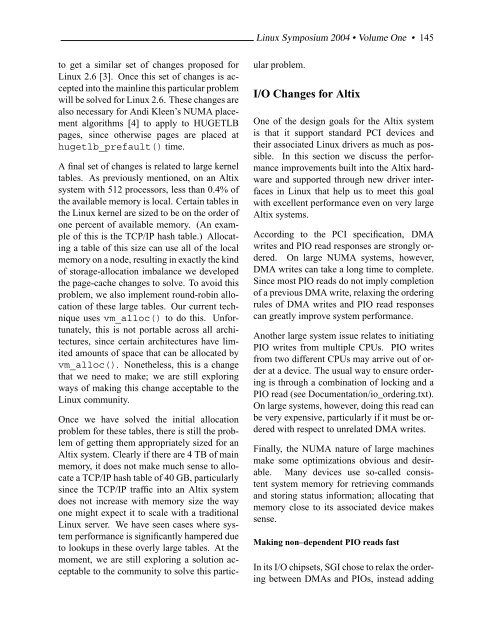Create successful ePaper yourself
Turn your PDF publications into a flip-book with our unique Google optimized e-Paper software.
<strong>Linux</strong> Symposium 2004 • Volume <strong>One</strong> • 145<br />
to get a similar set of changes proposed for<br />
<strong>Linux</strong> 2.6 [3]. Once this set of changes is accepted<br />
into the mainline this particular problem<br />
will be solved for <strong>Linux</strong> 2.6. <strong>The</strong>se changes are<br />
also necessary for Andi Kleen’s NUMA placement<br />
algorithms [4] to apply to HUGETLB<br />
pages, since otherwise pages are placed at<br />
hugetlb_prefault() time.<br />
A final set of changes is related to large kernel<br />
tables. As previously mentioned, on an Altix<br />
system with 512 processors, less than 0.4% of<br />
the available memory is local. Certain tables in<br />
the <strong>Linux</strong> kernel are sized to be on the order of<br />
one percent of available memory. (An example<br />
of this is the TCP/IP hash table.) Allocating<br />
a table of this size can use all of the local<br />
memory on a node, resulting in exactly the kind<br />
of storage-allocation imbalance we developed<br />
the page-cache changes to solve. To avoid this<br />
problem, we also implement round-robin allocation<br />
of these large tables. Our current technique<br />
uses vm_alloc() to do this. Unfortunately,<br />
this is not portable across all architectures,<br />
since certain architectures have limited<br />
amounts of space that can be allocated by<br />
vm_alloc(). Nonetheless, this is a change<br />
that we need to make; we are still exploring<br />
ways of making this change acceptable to the<br />
<strong>Linux</strong> community.<br />
Once we have solved the initial allocation<br />
problem for these tables, there is still the problem<br />
of getting them appropriately sized for an<br />
Altix system. Clearly if there are 4 TB of main<br />
memory, it does not make much sense to allocate<br />
a TCP/IP hash table of 40 GB, particularly<br />
since the TCP/IP traffic into an Altix system<br />
does not increase with memory size the way<br />
one might expect it to scale with a traditional<br />
<strong>Linux</strong> server. We have seen cases where system<br />
performance is significantly hampered due<br />
to lookups in these overly large tables. At the<br />
moment, we are still exploring a solution acceptable<br />
to the community to solve this particular<br />
problem.<br />
I/O Changes for Altix<br />
<strong>One</strong> of the design goals for the Altix system<br />
is that it support standard PCI devices and<br />
their associated <strong>Linux</strong> drivers as much as possible.<br />
In this section we discuss the performance<br />
improvements built into the Altix hardware<br />
and supported through new driver interfaces<br />
in <strong>Linux</strong> that help us to meet this goal<br />
with excellent performance even on very large<br />
Altix systems.<br />
According to the PCI specification, DMA<br />
writes and PIO read responses are strongly ordered.<br />
On large NUMA systems, however,<br />
DMA writes can take a long time to complete.<br />
Since most PIO reads do not imply completion<br />
of a previous DMA write, relaxing the ordering<br />
rules of DMA writes and PIO read responses<br />
can greatly improve system performance.<br />
Another large system issue relates to initiating<br />
PIO writes from multiple CPUs. PIO writes<br />
from two different CPUs may arrive out of order<br />
at a device. <strong>The</strong> usual way to ensure ordering<br />
is through a combination of locking and a<br />
PIO read (see Documentation/io_ordering.txt).<br />
On large systems, however, doing this read can<br />
be very expensive, particularly if it must be ordered<br />
with respect to unrelated DMA writes.<br />
Finally, the NUMA nature of large machines<br />
make some optimizations obvious and desirable.<br />
Many devices use so-called consistent<br />
system memory for retrieving commands<br />
and storing status information; allocating that<br />
memory close to its associated device makes<br />
sense.<br />
Making non–dependent PIO reads fast<br />
In its I/O chipsets, SGI chose to relax the ordering<br />
between DMAs and PIOs, instead adding

















